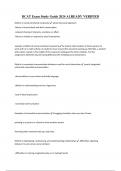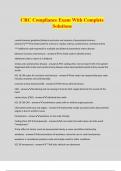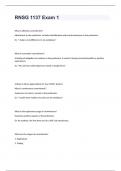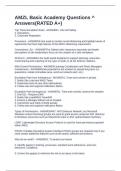Climate Variability - 13/09
● Weather is the temperature at a particular place and time
● Climate is the average temperature in a region, over a period of time
● Usually 10’s of km and 30 years
● “Climate is what you expect, weather is what you get”
● This also applies to: humidity, cloudiness, precipitation etc, all weather/climate
parameter
A paleoclimatological proxy is a measurable quantity, such as historical data, tree rings,
composition of trapped atmosphere in ice cores, fossil pollen, ocean sediments, coral that
allows reconstruction of climate variability
What is O18?
● O18 is just like O16, oxygen but slightly heavier (isotope)
● It naturally occurs but physical & chemical processes involving O18 happen slightly
differently than for O16
● e.g. H2O16 evaporates more easily from ocean than H2O18 (due to weight)
● O18/O16 ratio in shells of foraminifera depends on temperature
● When forams die, they precipitate to ocean floor
● Higher δO18 indicates lower temperatures/more ice
● Allows temperature records back to ~100 Myr
An atmospheric archive:
Snow on snow traps the air by compacting it. It shows a representation of the atmosphere at
the time.
Methane maybe kickstarts CO2 rise
Milankovitsch: how the earth faces the sun.
● Wat zegt dit?:
Temperature during Glacial-interglacials is forced through periodic changes in Earth’s
orbit
● CO2 is in this case not a forcing (it is actually delayed compared to temperature) but
provides a positive feedback
● Reason for increased CO2 at higher temperatures is not clear
● Colder ocean can hold more CO2 ?
● Sea ice prevents gassing of oceanic CO2 into atmosphere
Internal variability and external forcing
● Internal variability is defined as the variability that arises from the complexity of the
climate system. The year-to-year variability of temperature and precipitation over a
relatively small time frame is usually internal variability. Variability in ocean
temperatures, and variability caused by el Nino belongs to this type.
● The overall rise in temperature as forced through the increase in Co2 is external
● Temperature is always changing in space and time (weather)
, ● Global temperature is really the surface temperature and tells us little about
temperatures
○ in the ocean
○ high up in atmosphere
Climate sensitivity:
Definition: The temperature increase resulting from a doubling of CO2 in the atmosphere, C
in S in Ccelcius.
Climate sensitivies:
● TCR: Transient Climate Response
○ Temperature increase after doubling of CO2
○ TCR is sensitivity on short time-scales and so most useful for policy
● ECS: Equilibrium Climate Sensitivity
○ Temperature increase after deep ocean warming reaches equilibrium
● ESS: Earth System Sensitivity
○ Temperature increase after ice sheets reach equilibrium
○ ECS and in particular ESS include all relevant feedbacks (even very slow
ones) and is a better indication of how the whole system reacts.
Causes for warming/cooling in the past
● Paleocene-Eocene Thermal Maximum (PETM): unknown (volcanism?, fires?). Large
amount of CO2 released, possibility of CH4 positive feedback
● Eocene Climatic Optimum: unknown. Equable climate problem.
● Eocene cooling: growth of marine biosphere (plankton, azolla): CO2 drawdown
● Sudden Eocone-Oligocene cooling: continental movement? - insulation of continent
from equatorial heat
Physics of Radiation
Light is either a:
● wave
● particle
Objects can:
● Radiate (emit)
● Transmit light
○ Part of the light was
■ Absorbed
■ Scattered
Atoms:
● Outer orbits has more energy than inner orbits
● So the energy state changes when a an electron changes orbit
● Atoms “prefer” to be in lowest possible energy state
, ●
● Quantum mechanics teaches that the electrons in an atom can be in multiple discrete
energy states. If an electron moves to a lower state, the atom emits light. If an atom
absorbs light, an electron moves to a higher state.
● Quantum mechanics teaches that the atoms in a molecule can rotate/vibrate at
discrete energy states. A change of rotation/vibration to a lower state, causes the
molecule to emit light. Similarly, absorption can happen by changing to a
rotation/vibration level at a higher energy state
Absorption in earth’s atmosmphere: (by looking at spectrums)
● Very little absorption in visible
● Very little absorption in VIS
● Much absorption in IR from H2O (water vapour) and CO2
● Much absorption in UV from O3 and O2
● Strong IR absorbers not shown: CH4 and N2O
How do dense bodies emit light?
● The denser the bodies, the more different molecules packed closely together,
the more wavelength it emits and absorbs:
Spectrum of a wavelength only depends on temperature: material does not matter!
, Black body radiation:
● A black body absorbs all radiation that falls on it > gets hot and emits
● This does not mean that the object that object will appear black
○ Object will radiate at wavelengths set by temperature (
) = wavelength of maximum radiation
● Plank’s law is often a good approximation even if the body is not black body
● Total radiation flux is also set by temperature (Stefan-Boltzmann law:
) sigma tekentje is constante van planck
Grey bodies:
● Even bodies that are not strictly speaking black body, can nevertheless be described
as such (with small modification):
●
● When emissivity is 1, the grey body is a black body
● Often, bodies are like black bodies for some wavelengths and grey bodies for other
wavelengths
Pictures explained: garbage bag does not absorb infrared wavelength, so radiation of the
hand goes straight trough to camera. Garbage bag does emit something which is the blue
In the visual you see the reflected light. Glasses absorbs infrared light.
● Weather is the temperature at a particular place and time
● Climate is the average temperature in a region, over a period of time
● Usually 10’s of km and 30 years
● “Climate is what you expect, weather is what you get”
● This also applies to: humidity, cloudiness, precipitation etc, all weather/climate
parameter
A paleoclimatological proxy is a measurable quantity, such as historical data, tree rings,
composition of trapped atmosphere in ice cores, fossil pollen, ocean sediments, coral that
allows reconstruction of climate variability
What is O18?
● O18 is just like O16, oxygen but slightly heavier (isotope)
● It naturally occurs but physical & chemical processes involving O18 happen slightly
differently than for O16
● e.g. H2O16 evaporates more easily from ocean than H2O18 (due to weight)
● O18/O16 ratio in shells of foraminifera depends on temperature
● When forams die, they precipitate to ocean floor
● Higher δO18 indicates lower temperatures/more ice
● Allows temperature records back to ~100 Myr
An atmospheric archive:
Snow on snow traps the air by compacting it. It shows a representation of the atmosphere at
the time.
Methane maybe kickstarts CO2 rise
Milankovitsch: how the earth faces the sun.
● Wat zegt dit?:
Temperature during Glacial-interglacials is forced through periodic changes in Earth’s
orbit
● CO2 is in this case not a forcing (it is actually delayed compared to temperature) but
provides a positive feedback
● Reason for increased CO2 at higher temperatures is not clear
● Colder ocean can hold more CO2 ?
● Sea ice prevents gassing of oceanic CO2 into atmosphere
Internal variability and external forcing
● Internal variability is defined as the variability that arises from the complexity of the
climate system. The year-to-year variability of temperature and precipitation over a
relatively small time frame is usually internal variability. Variability in ocean
temperatures, and variability caused by el Nino belongs to this type.
● The overall rise in temperature as forced through the increase in Co2 is external
● Temperature is always changing in space and time (weather)
, ● Global temperature is really the surface temperature and tells us little about
temperatures
○ in the ocean
○ high up in atmosphere
Climate sensitivity:
Definition: The temperature increase resulting from a doubling of CO2 in the atmosphere, C
in S in Ccelcius.
Climate sensitivies:
● TCR: Transient Climate Response
○ Temperature increase after doubling of CO2
○ TCR is sensitivity on short time-scales and so most useful for policy
● ECS: Equilibrium Climate Sensitivity
○ Temperature increase after deep ocean warming reaches equilibrium
● ESS: Earth System Sensitivity
○ Temperature increase after ice sheets reach equilibrium
○ ECS and in particular ESS include all relevant feedbacks (even very slow
ones) and is a better indication of how the whole system reacts.
Causes for warming/cooling in the past
● Paleocene-Eocene Thermal Maximum (PETM): unknown (volcanism?, fires?). Large
amount of CO2 released, possibility of CH4 positive feedback
● Eocene Climatic Optimum: unknown. Equable climate problem.
● Eocene cooling: growth of marine biosphere (plankton, azolla): CO2 drawdown
● Sudden Eocone-Oligocene cooling: continental movement? - insulation of continent
from equatorial heat
Physics of Radiation
Light is either a:
● wave
● particle
Objects can:
● Radiate (emit)
● Transmit light
○ Part of the light was
■ Absorbed
■ Scattered
Atoms:
● Outer orbits has more energy than inner orbits
● So the energy state changes when a an electron changes orbit
● Atoms “prefer” to be in lowest possible energy state
, ●
● Quantum mechanics teaches that the electrons in an atom can be in multiple discrete
energy states. If an electron moves to a lower state, the atom emits light. If an atom
absorbs light, an electron moves to a higher state.
● Quantum mechanics teaches that the atoms in a molecule can rotate/vibrate at
discrete energy states. A change of rotation/vibration to a lower state, causes the
molecule to emit light. Similarly, absorption can happen by changing to a
rotation/vibration level at a higher energy state
Absorption in earth’s atmosmphere: (by looking at spectrums)
● Very little absorption in visible
● Very little absorption in VIS
● Much absorption in IR from H2O (water vapour) and CO2
● Much absorption in UV from O3 and O2
● Strong IR absorbers not shown: CH4 and N2O
How do dense bodies emit light?
● The denser the bodies, the more different molecules packed closely together,
the more wavelength it emits and absorbs:
Spectrum of a wavelength only depends on temperature: material does not matter!
, Black body radiation:
● A black body absorbs all radiation that falls on it > gets hot and emits
● This does not mean that the object that object will appear black
○ Object will radiate at wavelengths set by temperature (
) = wavelength of maximum radiation
● Plank’s law is often a good approximation even if the body is not black body
● Total radiation flux is also set by temperature (Stefan-Boltzmann law:
) sigma tekentje is constante van planck
Grey bodies:
● Even bodies that are not strictly speaking black body, can nevertheless be described
as such (with small modification):
●
● When emissivity is 1, the grey body is a black body
● Often, bodies are like black bodies for some wavelengths and grey bodies for other
wavelengths
Pictures explained: garbage bag does not absorb infrared wavelength, so radiation of the
hand goes straight trough to camera. Garbage bag does emit something which is the blue
In the visual you see the reflected light. Glasses absorbs infrared light.










